Below are the top 10 Istanbul historical sites. Istanbul’s history blends Byzantine, Ottoman, and Roman influences. Here is our selection of the most interesting Istanbul historical sites:
Best of Istanbul Historical Sites – Table of Contents
Hagia Sophia
Location: Ayasofya-i Kebir Cami-i Şerifi, Sultan Ahmet, Ayasofya Meydanı No:1, 34122 Fatih/İstanbul. The official site website link (Turkish only) and the official Turkish Museums website. Opening Hours: Daily: 09:00 – 19:30. On Friday, the Hagia Sophia is typically closed for noon prayers from 12:30 until 14:30. Entrance Fee: The full-price adult (over 8 years old) entrance fee in February 2025 was €25.00.
Notes on Entrance: As of January 2024, Hagia Sophia has two entrances. The one on Sultanahmet Square is now exclusively for Turkish citizens visiting the worship area in the former narthex and nave. To better manage the over-tourism and visitor flow and preserve Hagia Sophia’s sanctity as a functioning mosque, new rules have been implemented, primarily separating tourist visits from prayer. Tourists now enter on the northeast side near the Fountain of Sultan Ahmet III through a designated entrance to the upper-level galleries. At the same time, the ground floor is reserved for worshippers. This separation, along with introducing an entrance fee for tourists, aims to reduce crowding, maintain a respectful atmosphere for those praying, and aid in preserving this historical and religious site. Women visitors must also wear a headscarf before they enter the upper gallery.
Commissioned by Byzantine Emperor Justinian and consecrated in 537 as a Christian basilica, Hagia Sophia stood as the pinnacle of Byzantine architectural achievement for nearly a millennium. Its magnificent dome, a marvel of engineering for its time, and its intricate mosaics spoke to the grandeur of the Byzantine Empire. Following the Ottoman conquest of Constantinople in 1453, Hagia Sophia was converted into a mosque, adding minarets and Islamic calligraphic inscriptions, reflecting the new rulers’ faith. After establishing the Turkish Republic as part of his secularisation policy agenda, founding President Atatürk turned Hagia Sophia into a museum in 1935. 85 years later, President Erdoğan ordered that the Hagia Sophia be reconverted into a mosque, “Ayasofya-i Kebir Cami-i Şerifi,” which opened for prayers on 24 July 2020.
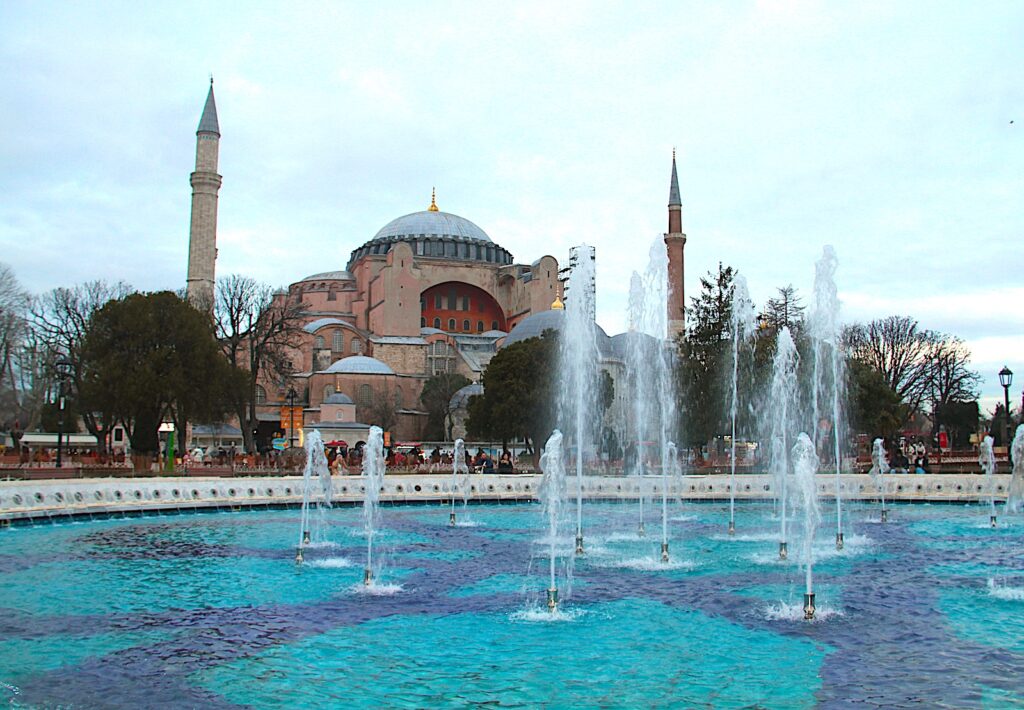
The architectural features of Hagia Sophia are genuinely breathtaking. Its most iconic element is the massive central dome, which creates a sense of awe-inspiring space. Using pendentives to support the dome was a revolutionary engineering technique, allowing for a seamless transition from the square base to the circular dome. The building has exquisite marble columns, intricate mosaics, and vast open spaces. These elements combine to create a sense of both grandeur and spiritual reverence. Blending Byzantine and Ottoman architectural styles further enhances the building’s unique character. The visible signs of Christianity and Islam within the building powerfully remind visitors of its complex past. Hagia Sophia’s sheer scale, rich history, and artistic treasures make it a truly remarkable and significant landmark. It is a place where history, art, and faith converge, offering visitors a glimpse into the past and a sense of wonder.
To maximise your Hagia Sophia experience, aim for weekday early mornings, such as Tuesdays or Wednesdays, avoiding Fridays due to noon prayers to ensure entry. During the spring or autumn, shoulder seasons to avoid peak crowds and enjoy pleasant weather. Under the rules implemented in January 2024, professional guides can no longer give tours inside the Hagia Sophia. Instead, visitors can scan a QR code on their phone (or rent headsets) to access an audio-visual tour. The tour offers details on 10 points of interest in over 20 languages.
Topkapı Palace Museum
Location: Topkapı Sarayı Müzesi, Cankurtaran, 34122 Fatih/İstanbul. The official Istanbul Heritage National Places website. Opening Hours: Wednesday – Monday: 09:00 – 17:30, Closed Tuesdays. Entrance Fee: The full-price adult entrance fee in February 2025 was the TL equivalent of €52.00 (includes entry to Topkapı Palace, the Harem and Hagia Irene).
Topkapı Palace, commissioned by Sultan Mehmed II after the 1453 conquest of Constantinople, served as the primary residence of Ottoman sultans for nearly four centuries. Its construction began in 1459 and continued through various sultans’ reigns, resulting in a complex of courtyards, pavilions, and buildings that reflect the empire’s growth and changing tastes. Initially, it was the centre of Ottoman power, where political decisions were made and imperial life unfolded. Following the establishment of the Turkish Republic in 1924, the palace was transformed into a museum, opening its doors to the public.
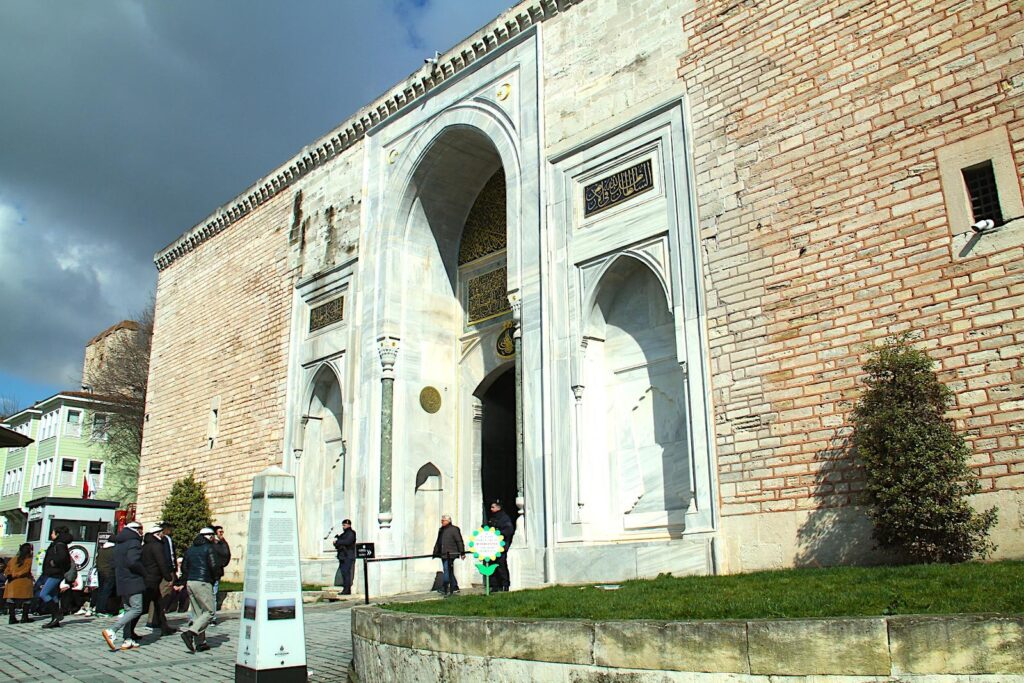
The palace’s architectural features are a testament to Ottoman craftsmanship and imperial grandeur. It is organised around four central courtyards, each serving a distinct purpose. The Harem, a separate section, housed the sultan’s family and concubines, offering a glimpse into the private lives of the Ottoman elite. The palace is adorned with intricate tilework, ornate ceilings, and stunning views of the Bosphorus, showcasing a blend of Islamic and Ottoman architectural styles. The treasury within the palace is renowned for its collection of precious jewels, including the Spoonmaker’s Diamond and the Topkapi Dagger.
Beyond its architecture, Topkapi Palace holds a vast collection of historical artefacts. These include imperial robes, weapons, porcelain, and religious relics, providing insight into the daily life and cultural richness of the Ottoman Empire. The Sacred Relics Chamber, in particular, houses items believed to have belonged to the Prophet Muhammad, adding to the palace’s religious and historical significance. The palace’s strategic location, overlooking the Golden Horn and the Sea of Marmara, further enhances its allure, making it a must-visit destination for those seeking to understand the legacy of the Ottoman Empire.
Blue Mosque (Sultanahmet Mosque)
Location: Sultanahmet Camii, Binbirdirek, At Meydanı Cd No:10, 34122 Fatih/İstanbul. The official site website link (English. Opening Hours: Daily: 09:00 – 18:00 (The mosque closes to non-worshippers during the five daily prayer times). Entrance Fee: As of February 2025, entry to the mosque is free.
Notes on entry: Unlike Hagia Sophia, entry to the Sultanahmet Mosque is free. However, visitors must adhere to strict rules: respectful attire is mandatory, meaning both men and women must cover their shoulders and knees, and women must also cover their hair with a scarf. Visitors must remove their shoes before entering, and entry is prohibited during prayer times. Photography is generally allowed, but visitors should be mindful and avoid disrupting worshippers. Security checks are in place, which can result in wait times, especially during peak tourist seasons.
The Sultanahmet Mosque, more commonly known as the Blue Mosque, was constructed between 1609 and 1616 during the reign of Sultan Ahmed I. He commissioned it as a grand imperial mosque to rival the Hagia Sophia. Its construction was a period of relative peace for the Ottoman Empire, and the sultan aimed to create a lasting architectural masterpiece. The mosque’s design blends traditional Islamic architecture with Byzantine elements, showcasing the historical and cultural influences that shaped Istanbul. The location was carefully chosen, placing it near the Hagia Sophia and the Hippodrome, creating a powerful visual statement of Ottoman imperial power.

The mosque’s most striking feature is its six minarets, a rare architectural element that initially caused controversy as it was equal to the number of minarets at the Kaaba in Mecca. To resolve this, a seventh minaret was later added to the Kaaba. The Blue Mosque’s interior is adorned with over 20,000 handmade İznik tiles, predominantly blue, which give the mosque its popular name. These tiles feature traditional floral and geometric patterns, creating a mesmerizing visual effect. The central dome, supported by four massive pillars, rises to 43 meters, creating a vast, awe-inspiring space. The mosque’s numerous windows allow natural light to flood the interior, illuminating the intricate tilework and creating a serene atmosphere.
Beyond its architectural beauty, the Blue Mosque serves as a functioning place of worship, maintaining its religious significance. It also stands as a testament to the Ottoman Empire’s artistic and engineering prowess. The mosque’s courtyard, with its ablution facilities and surrounding arcades, provides a peaceful space for contemplation and prayer. Its location within the heart of Istanbul’s historical peninsula makes it a central landmark and a symbol of the city’s rich cultural heritage. The Blue Mosque attracts visitors worldwide, offering a glimpse into the grandeur of Ottoman architecture and the enduring legacy of Islamic art.
The Grand Bazaar
Location: Kapalı Çarşı, Beyazıt, 34126 Fatih/İstanbul (note: covers a vast area). The official site website link (Turkish only) and the official Turkish Museums website. Opening Hours: Monday – Saturday: 08:30 – 19:00, closed Sundays and public holidays. Entrance Fee: Free to enter.
The Grand Bazaar, or Kapalıçarşı, is one of the world’s oldest and largest covered markets, with a history dating back to the 15th century. Its construction began shortly after the Ottoman conquest of Constantinople in 1453, under the reign of Sultan Mehmed II. Initially, it was a small trading centre, but it rapidly expanded over the centuries, becoming a vital hub for commerce and a central part of Istanbul’s economic and social life. The bazaar’s labyrinthine network of streets and shops evolved organically, with additions and renovations reflecting the changing tastes and needs of the city. It has survived numerous fires and earthquakes throughout its history, subsequently being rebuilt and restored and maintaining its historical significance.
The Grand Bazaar’s most distinctive feature is its covered structure, comprising over 60 streets and over 4,000 shops. Its architecture blends Ottoman and traditional Turkish styles with vaulted ceilings, arched passageways, and decorative tilework. The bazaar is organized into sections based on the type of goods sold, creating specialised areas for jewellery, carpets, textiles, spices, and ceramics. The atmosphere is vibrant and bustling, with vendors displaying their wares and engaging in lively bargaining. The bazaar’s historical significance is further enhanced by its traditional hans, or caravanserais, which were once used as lodging and storage for travelling merchants.
The Grand Bazaar offers a diverse range of shops catering to both locals and tourists. You can find exquisite jewellery, including gold, silver, precious stones, and antique and contemporary carpets, kilims, and textiles. Leather goods, ceramics, spices, and Turkish Delight are popular. Additionally, shops are selling traditional Turkish clothing, souvenirs, and handicrafts. For entry, the Grand Bazaar has numerous gates, each leading into its maze-like interior. However, the most commonly used and easily recognisable entrances are the Beyazıt Gate, near Beyazıt Mosque (to the west of the bazaar), and the Nuruosmaniye Gate, near Nuruosmaniye Mosque (to the east of the bazaar). Entering from these gates provides a convenient starting point for exploring the bazaar’s vast and captivating world.
Galata Tower
Location: Galata Kulesi, Bereketzade, 34421 Beyoğlu/İstanbul. The official Turkish Museums website. Opening Hours: Daily: 08:30 – 22:00 (21:00 in winter). Entrance Fee: The full-price adult entrance fee in February 2025 was €30.00.
The Galata Tower, a prominent landmark in Istanbul, has a rich and varied history. Initially built by the Genoese in 1348 as part of their fortifications of Galata, then a separate colony, it was named the Christea Turris (Tower of Christ). Over the centuries, it served different purposes under various rulers, including as a fire watchtower during the Ottoman era. In the 18th century, a conical roof was added, giving it its current iconic silhouette. The tower has withstood numerous fires and earthquakes, undergoing restorations and modifications throughout its existence, and it’s a testament to the city’s layered history.
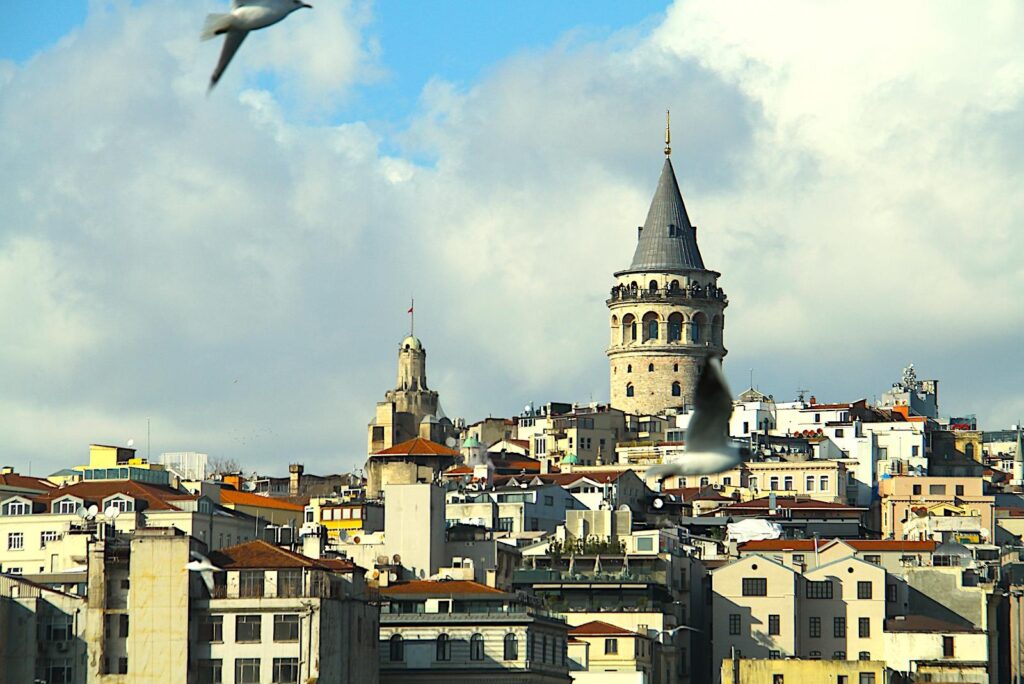
The Galata Tower’s most striking feature is its height and panoramic views. Standing approximately 67 meters (220 feet) tall, it offers breathtaking 360-degree vistas of Istanbul, including the Golden Horn, the Bosphorus, and the historical peninsula. Its cylindrical stone structure, capped by a conical roof, is a distinctive element of the city’s skyline. The tower has been modernised inside to accommodate visitors, with an elevator providing access to the upper levels. The exterior maintains its historical appearance, while the interior has been adapted for contemporary use.
Visitors can find exhibits inside the Galata Tower detailing its history, its role in Istanbul’s past, and the city’s broader historical context. The tower has exhibits on several levels, including displays of historical artefacts and information about its various functions over time. It has nine floors and a café on the upper levels. The highest level is the observation deck, which provides panoramic views.
Dolmabahçe Palace
Location: Dolmabahçe Sarayı, Vişnezade, Dolmabahçe Cd. No:2, 34357 Beşiktaş/İstanbul. The official Directorate of National Palaces site website link. Opening Hours: Tuesday – Saturday: 09:00 – 17:00, closed Monday. Entrance Fee: The full-price adult entrance fee in February 2025 was the TL equivalent of €39.00 (including entry to the harem and painting museum).
Dolmabahçe Palace, commissioned by Sultan Abdülmecid I and built between 1843 and 1856, marks a significant shift in Ottoman architectural and political history. Seeking a more modern and European-style residence, the sultan moved away from the traditional Topkapı Palace. The palace’s construction coincided with the Tanzimat reforms, a period of modernisation and westernisation in the Ottoman Empire. It served as the primary imperial residence until the abolition of the Ottoman Sultanate in 1922. Notably, Mustafa Kemal Atatürk, the founder of the Republic of Turkey, also used the palace as his presidential residence in Istanbul and passed away there in 1938.
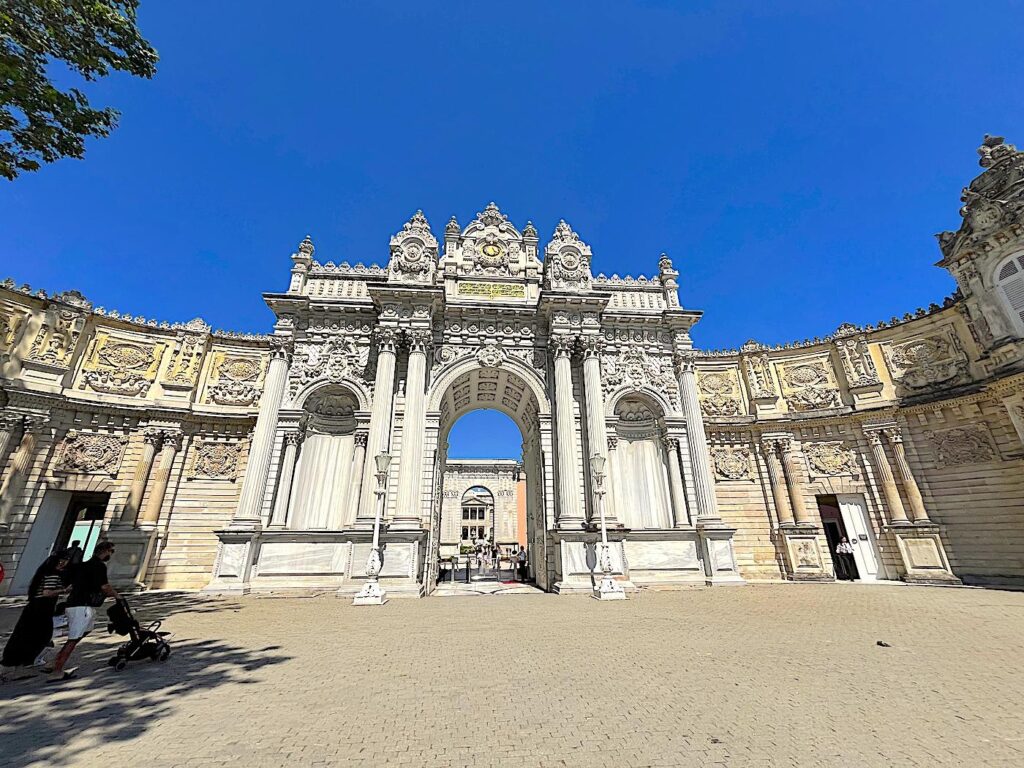
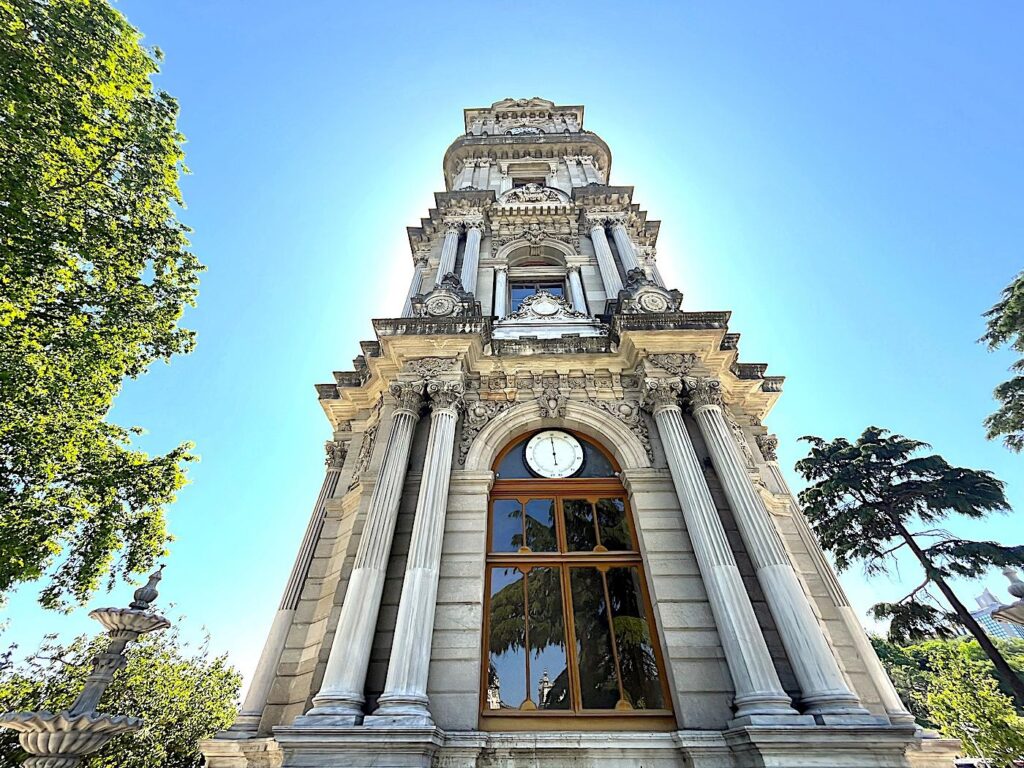

The palace’s architecture is a striking blend of Baroque, Rococo, and Neoclassical styles, reflecting the Ottoman elite’s fascination with European trends. It features a grand facade overlooking the Bosphorus, a massive Ceremonial Hall with a crystal chandelier gifted by Queen Victoria of Great Britain, and a lavishly decorated interior with gold leaf, crystal, and valuable carpets. The Harem, a separate section of the palace, showcases the private lives of the sultan’s family. The palace’s garden, with its fountains and manicured lawns, further enhances its elegance. The Clock Tower and the Sultan’s Mosque, located within the palace complex, add to its architectural diversity.
Inside Dolmabahçe Palace, visitors can explore a wealth of historical artefacts and exhibits. The palace’s collection includes furniture, paintings, porcelain, and textiles, offering a glimpse into the opulent lifestyle of the Ottoman sultans. The Ceremonial Hall displays the world’s largest Bohemian crystal chandelier, a testament to the palace’s extravagance. The Harem section showcases the private quarters of the sultan’s family, with its elaborate decorations and furnishings. The Painting Museum within the palace houses a collection of 19th-century European and Ottoman paintings. The room where Atatürk passed away is preserved as a memorial, with the clock stopped at the time of his death, adding a poignant historical dimension to the visit.
Rumeli Fortress
Location: Rumeli Hisarı, Yahya Kemal Cd., 34470 Sarıyer/İstanbul. The official Turkish Museums website. Opening Hours: Tuesday – Sunday: 09:00 – 18:00 (winter ticket office closes 16:00), closed Mondays. Entrance Fee: The full-price adult entrance fee in February 2025 was the TL equivalent of €6.00.
Rumeli Fortress, or Rumelihisarı, was built by Sultan Mehmed II in 1452, just before the conquest of Constantinople; its purpose was to control the Bosphorus Strait and cut off Byzantine aid from the Black Sea. Constructed in a remarkably short period, it worked with Anadolu Hisarı on the opposite shore to effectively blockade the city. This strategic move proved crucial in the Ottoman victory, marking the end of the Byzantine Empire. Over the centuries, the fortress served various purposes, including a customs checkpoint and a prison, before falling into disrepair.
The fortress’s design is a marvel of medieval military architecture. Its imposing walls, three main towers (one large and two smaller), and numerous smaller towers create a formidable defensive structure. The walls follow the terrain’s natural contours, enhancing its strategic positioning. The fortress’s interior is divided into sections, with courtyards, barracks, and a small mosque. The central tower, known as the Grand Tower, offers panoramic views of the Bosphorus, highlighting the fortress’s strategic importance. The use of locally sourced stone and the sheer scale of the construction illustrate the Ottoman engineering prowess of the time.
The Rumeli Fortress was opened as a museum in 1968, following restoration work started in 1953. Recent renovations between 2021 and 2024 focused on preserving the historical integrity of the fortress while enhancing its accessibility and visitor experience. The restoration efforts included structural repairs to the walls and towers, cleaning and conserving the stonework, and adding modern amenities such as lighting and pathways. The fortress also features an open-air amphitheatre that hosts cultural events and concerts during the summer months. The exhibits inside primarily consist of displays detailing the fortress’s construction, its role in the conquest of Constantinople, and its subsequent history. Artefacts found during archaeological excavations are also showcased, providing insights into the daily life of the soldiers and inhabitants of the fortress.
Basilica Cistern
Location: Yerebatan Sarnıcı, Alemdar, Yerebatan Cd. 1/3, 34110 Fatih/İstanbul. The official site website link and the official Turkish Museums website. Opening Hours: Daily: 09:00 – 23:50. Entrance Fee: The full-price adult entrance fee in February 2025 was the TL equivalent of €34.00, and €52.00 for the “night shift” after 19:30.
The Basilica Cistern, in Turkish Yerebatan Sarnıcı, is an ancient underground water reservoir built in the 6th century during the reign of Byzantine Emperor Justinian I. It was constructed to provide water to the Great Palace and other buildings in the city, especially during times of siege. The cistern’s strategic location and impressive engineering made it vital to Constantinople’s water infrastructure. After the Ottoman conquest, the cistern continued to be used, although it fell into disrepair over time. Rediscovered and restored in the mid-20th century, it has become a popular tourist attraction, offering a glimpse into the city’s ancient past.
The Basilica Cistern’s remarkable feature is its scale and architectural grandeur. Supported by 336 marble columns, many of which were recycled from older structures, the cistern creates a mesmerising subterranean space. The columns add to the cistern’s historical and artistic significance with their various styles and carvings. The two Medusa heads, used as bases for some of the columns, are particularly famous and shrouded in mystery. The cistern’s vaulted brick ceiling and the still, reflecting water create an atmospheric and somewhat eerie ambience. The subtle lighting and the sound of dripping water enhance the sense of being in a hidden, ancient world.
Inside the Basilica Cistern, visitors can explore the walkways installed above the water, allowing them to view the columns and the Medusa heads up close. Recent renovations have enhanced the visitor experience with improved lighting and sound systems. The cistern also hosts occasional art installations and special events, leveraging its unique environment. In recent years, the Basilica Cistern began hosting night performances with light shows and music, which add to the atmospheric experience. These light shows highlight the architecture, sculptures, and water and are accompanied by music that enhances the feeling of being in an ancient, magical space.
Kariye Mosque (Chora Church)
Location: Kariye Camii, Derviş Ali, Kariye Cami Sk. No:18, 34087 Fatih/İstanbul. The official Presidency of Religious Affairs website link (Turkish only) and the official Turkish Museums website. Opening Hours: Saturday – Thursday: 09:00 – 17:55, closed Friday. Entrance Fee: The full-price adult entrance fee in February 2025 is €20.00.
The Kariye Mosque, originally the Church of the Holy Saviour in Chora, is a Byzantine-era church renowned for its exquisite mosaics and frescoes. Constructed and reconstructed over centuries, its most significant form dates back to the 14th century, under the patronage of Theodore Metochites, a wealthy scholar and statesman. During the Ottoman conquest of Constantinople in 1453, the church was converted into a mosque known as the Kariye Camii. In 1948, it was secularised and turned into a museum, allowing its magnificent Byzantine artwork to be revealed and studied. In 2020, it was again converted into a mosque, sparking international debate due to its historical and artistic importance.
The Chora Church’s architectural features are a testament to Byzantine artistry. Its compact structure houses a rich collection of mosaics and frescoes that depict scenes from the life of Christ and the Virgin Mary and Old Testament stories. These artworks are considered some of the finest examples of late Byzantine art, showcasing a high level of detail, expression, and narrative skill. The church’s interior is divided into several sections, including the narthex, nave, and parecclesion, each adorned with intricate mosaics and frescoes. The building combines different architectural styles, reflecting the various periods of its construction and restoration.
Recent restoration work has focused on preserving the mosaics and frescoes and adapting the building for its new function as a mosque. This has included the installation of carpets for prayer and covering certain mosaics during prayer times, following Islamic tradition. The Kariye Mosque reopened for worship in 2022. Entry is free for worshippers, but there is an entrance fee for tourists. Opening hours are subject to change based on prayer times, so it’s best to check the current schedule before visiting. Foreigners must observe the same rules as all visitors: respectful attire is required (covering shoulders, knees, and hair for women), and shoes must be removed before entering. Photography is generally allowed, but visitors should be mindful and avoid disrupting worshippers during prayer.
Theodosian Walls
Location: İstanbul Surları (near the Kariye Mosque), Derviş Ali, Hoca Çakır Cd. No:1, 34087 Fatih/İstanbul. Opening Hours: Generally accessible. Entrance Fee: No fee to access or view the walls.
The Theodosian Walls, also known as the Walls of Constantinople, are a series of defensive stone walls that have surrounded and protected the city since its founding as Byzantium. Their construction began under Theodosius II in the 5th century, and they underwent numerous expansions and repairs over the centuries. These walls were a marvel of medieval military engineering, renowned for their strength and resilience. They played a crucial role in defending Constantinople against numerous sieges, including those by the Avars, Persians, Arabs, and Bulgarians. Despite their formidable defences, the walls ultimately fell to the Ottoman forces in 1453, marking the end of the Byzantine Empire.
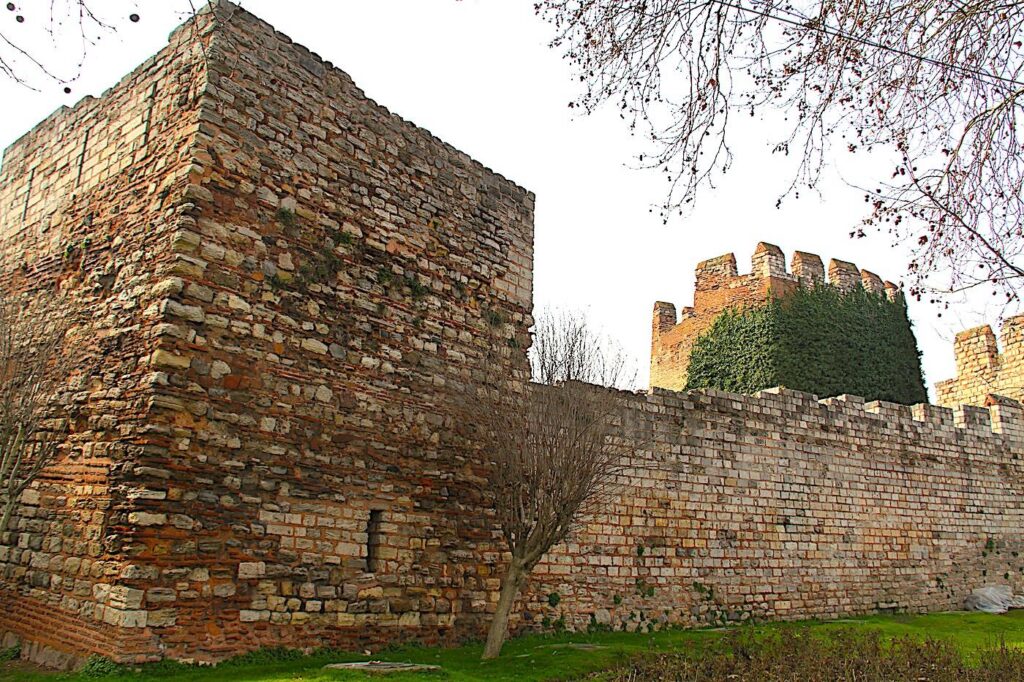
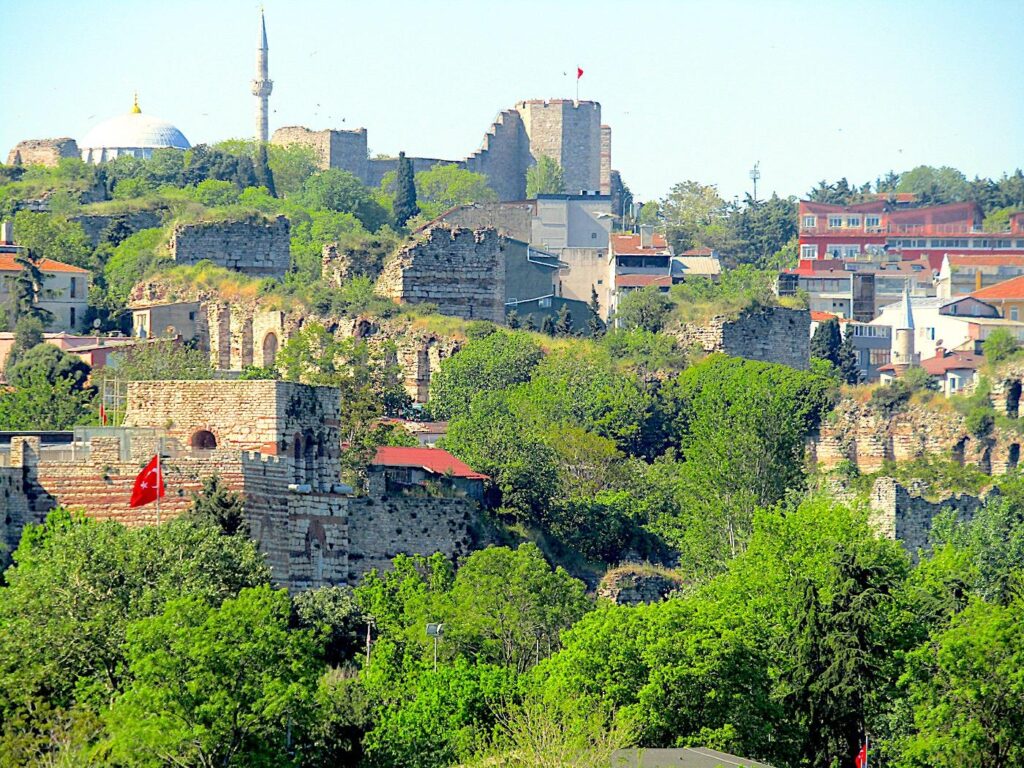
The walls are a complex system of triple-layered defences: an inner wall, an outer wall, and a moat. The tallest and strongest inner wall stood approximately 12 meters high and was punctuated by numerous towers. The lower but substantial outer wall provided an additional layer of defence. The moat ran along the outer wall and was designed to impede attackers. The walls’ construction involved the use of a combination of stone and brick, creating a robust and durable structure. The numerous gates along the walls, such as the Golden Gate and the Adrianople Gate, served as entry points into the city and were heavily fortified.
The area around the Chora Church/Kariye Mosque also offers good views of a restored section of the walls. Walking along the length of the walls allows visitors to appreciate their historical significance and the sheer scale of this ancient defensive system. Between the Topkapı (St. Romanus) and Mevlanakapı (Rhesion) gates, the section offers a well-preserved example of the walls’ triple-layered defences, including the inner and outer walls and the remnants of the moat. Another excellent viewing spot is near the Yedikule Fortress (Fortress of the Seven Towers), where the walls meet the Sea of Marmara. Here, you can observe the walls’ impressive scale and the fortress’s integration into the defensive system.
Points along the Theodosian Walls from southwest to northeast, highlighting some of the notable gates and towers with Google Maps locations on the respective links:
- Mermer Kule (Marble Tower) – The beginning of the land walls along the Sea of Marmara.
- Yedikule Fortress (Fortress of the Seven Towers) – Fortress integrated into the walls.
- Golden Gate (Altınkapı) – A ceremonial gate, richly decorated, used for imperial entrances.
- Belgrade Gate – The Xylokerkos Gate was named after a settlement of Belgrade artisans.
- Silivri Gate (Selymbria Gate) – One of the main gates for access into the city.
- Mevlanakapı (Rhesion Gate) – Another critical gate, often involved in historical sieges.
- Topkapı (St. Romanus Gate) – A crucial gate during the final Ottoman siege.
- Sulukule Gate – A smaller utilitarian gate.
- Adrianople Gate (Edirnekapı) – Known as the Charisius Gate, primary access from Thrace.
- Eğrikapı (Bent Gate) – The northeastern terminus of the land walls with an angled entrance.
